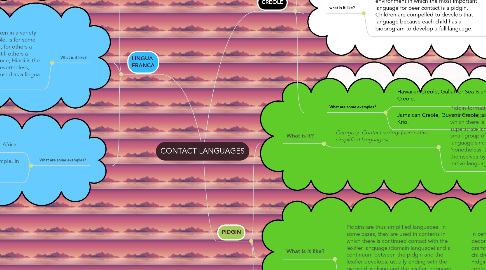
1. LINGUA FRANCA
1.1. What is it?
1.1.1. Category: Vernacular languages.
1.1.1.1. A lingua franca is a spoken language that used to facilitate the communication between groups of people who habitually do not share the same mother tongues
1.2. What is it like?
1.2.1. A lingua franca can be spoken in a variety of ways. English, for example, is for some speakers a native language, for others a second language, and for still others a foreign language. For instance, Hindi is the official language in India; nevertheless, English language is widely used as a lingua franca.
1.3. What are some examples?
1.3.1. Kiswahili is a lingua franca of East Africa.
1.3.2. English is a lingua franca, for example, in travel, business, technology, and international relations.
2. CREOLE
2.1. What is it?
2.1.1. Category: contact variety (native, fully elaborated languages)
2.1.1.1. Creole formation is first-language learning, also with restricted input. Usually, Creoles are developed by children because they are compelled to develop that language since each child has an innate grammar to create a full language as long as the child is in a linguistic environment.
2.1.1.1.1. Thus the role of first language acquisition was the key to the development of creole languages from pidgin languages.
2.2. what is it like?
2.2.1. Typically, creoles are developed by children who find themselves born into a multilingual environment in which the most important language for peer contact is a pidgin. Children are compelled to develop that language because each child has a bioprogram to develop a full language.
2.2.1.1. Children use this bio-program in the same way wherever they happen to be and the consequence is that ‘the grammatical structures of creoles are more similar to one another than they are to the structures of any other language.
2.3. What are some examples?
2.3.1. Hawaiian Creole, Gullah or Sea Islands Creole.
2.3.2. Jamaican Creole, Guyana Creole, and Krio.
3. PIDGIN
3.1. What is it?
3.1.1. Category: Contact variety (non-native, simplified languages)
3.1.1.1. Pidgin formation is second-language learning with restricted input. This language develops in situations in which there is a group of people who share a common superstrate language or domain language, but there is a small group of people that have a lack of access to this language since it does not their mother tongue. Nonetheless, they create a pidgin form of it to use among themselves by combining the domain tongue with their native language.
3.2. What is it like?
3.2.1. Pidgins are thus simplified languages. In some cases, they are used in contexts in which there is continued contact with the lexifier language (domain language) and a continuum between the pidgin and the lexifier develops, usually ending with the pidgin dissolving and the lexifier language being spoken.
3.2.1.1. In certain cases, Pidgin used by children becomes more elaborated and regularized grammatically and acquires register. Since children reorganize the structure of the Pidgin allowing to be used in social contexts.
3.3. What are some examples?
3.3.1. West African Pidgin Portuguese, Cameroon Pidgin English, Tok Pisin, and Chinese Pidgin English (now virtually extinct)
3.3.2. Asmara Pidgin (spoken in parts of Ethiopia)
